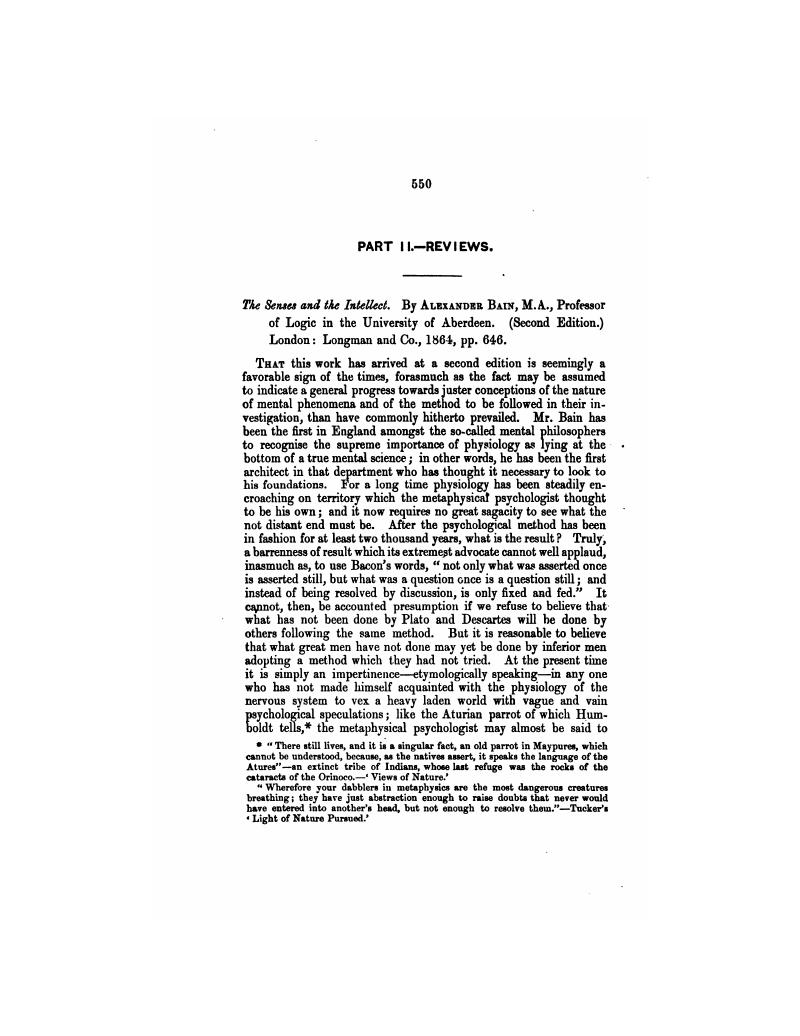No CrossRef data available.
Article contents
The Senses and the Intellect. by Alexander Bain, M. A. Professor of Logic in the University of Aberdeen. (Second Edition.) London: Longman and Co., 1864, pp. 646.
Published online by Cambridge University Press: 19 February 2018
Abstract

- Type
- Part I.—Original Articles
- Information
- Copyright
- Copyright © Royal College of Psychiatrists, 1865
References
∗ “There still lives, and it is a singular fact, an old parrot in Maypures, which cannot be understood, because, as the natives assert, it speaks the language of the Atures”—an extinct tribe of Indians, whose last refuge was the rocks of the cataracts of the Orinoco.—‘Views of Nature.’Google Scholar “Wherefore your dabblers in metaphysics are the most dangerous creatures breathing; they have just abstraction enough to raise doubts that never would have entered into another's head, but not enough to resolve them.”—Tucker's ‘Light of Nature Pursued.’Google Scholar
∗ ‘British and Foreign Med.—Chir. Review,’ 1860.Google Scholar
∗ The way in which Mr. Bain speaks of this diffusion of emotion, as if it were something hitherto almost entirely neglected, is rather surprising. In reality it has been over and over again dwelt upon with much greater exactness than by Mr. Bain. Bichat (‘Sur la Vie et la Mort’) located the passions in the organs of organic life, so much was he impressed by it; Henle described the emotions as sympathies between the organ of thought and the bodily nerves (‘Ration. Pathologie,’ vol. i, 1846); Domrich treats in detail of the influence of the feelings not only on motor nerves, but on the different organs and upon nutrition (‘Die Psychischen Zustände, ihre organische Vermittlung,’ &c., 1849); and Waclismuth (‘Allgemeine Pathologie der Seele), is sufficiently distinct upon the subject; as most German manuals of psychology are.Google Scholar
∗ Since the above was written we have met with a little work by C. S. Cornalina, (‘Zur Theorie des Sehens mit Rücksicht auf die neuesten Arbeiten in diesem Gebiete’ Halle, 1864,) which contains a complete summary of all the arguments in favour of the muscular sensations of the eye as the important agents in vision. A larger work by the same author is ‘Theorie des Sehens nnd raumlichen Vorstellens’ 1861. It appears that the influence of the muscular sensations was set forth by Steinbuch as early as 1811; first applied in a comprehensive theory by Herbart and his school; is expounded in detail by Cornelius, and supported by Lötse and Wundt. Waits, however, holds that the sensations of colour may, without any co-operation of muscular feeling, lead to the conception of extension in space.Google Scholar





eLetters
No eLetters have been published for this article.